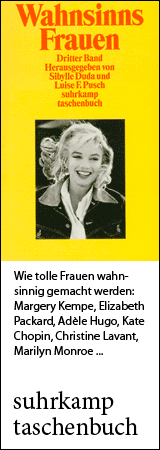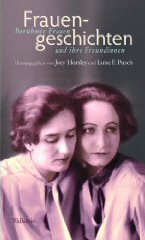Biographies Claudia de’ Medici

Wikimedia Commons
(Claudia von Medici)
*4 June 1604 in Florence
+25 December 1648 in Innsbruck
Ruler of Tyrol (Landesfürstin)
Biography • Literature & Sources
Biography
Claudia de’ Medici, daughter of the art collector and founder of the Villa Medici in Rome, was already engaged by the age of four. Her parents had her educated in a convent, where she had lessons in the harp and the lute, painted pictures, and learned what was necessary for a princess to know: piety. In a youthful portrait we see her sitting with her hands modestly on top of each other, her curly hair kept in check by a lace cap and her bare neck guarded by a stiff ruffle.
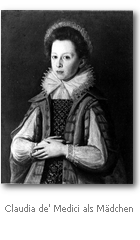
Claudia de’ Medici had been promised to the heir to the throne of Urbino, who at age sixteen wrote her a pas-sionate love-letter, afraid that her family might give her as a bride to Emperor Ferdinand II. But her family kept to its agreement. In 1621 the young bride set out for Urbino fully inclined to fulfill the expectations placed upon her to bear many princes. But on her arrival she faced bitter disappointment. Her husband had installed his mistress, an actress, in the palace as well and had no intention of giving up his freewheeling way of life. Outraged, she fled to Pesaro. Only when Federigo promised to change did she return to Urbino. Here she bore her first child in 1622, a daughter, Vittoria – no heir to the throne, but proof of her promising fertility.
With the sudden death of Federigo the doubtful marital happiness, only just begun, came to an abrupt end. Prin-cess Vittoria would not qualify to rule over a duchy. For Claudia de’ Medici this was a catastrophe. She had to leave Urbino and return to the convent. Harp strains replaced the music of opulent celebration.
Fortunately, her sister-in-law knew a of remedy for the wealthy 19-year-old widow. Her brother Leopold, a bishop and the sovereign of Tirol, was up to his neck in debt. Marriage would help both parties, and the age difference of 18 years was no impediment for a man of vigor. Leopold’s childhood portraits show a bright-eyed, happy little roly-poly, an unlikely candidate for celibacy or the ascetic life. The negotiations between the Habsburgs and the Medici eventually worked out to everyone’s satisfaction. Leopold the Pious, friend of the fine arts wanted to do just one more thing before giving his final assent: to see his bride-to-be face-to-face at least once, in all discretion. Claudia had fallen ill with the pox when she was 16. What if her pretty face had become deformed, her smooth skin covered with scars? To his great relief Leopold V did not have to answer this question. His bride too was content. She would marry a former cleric, free of sin and debauchery, strictness and abstemiousness. Both enjoyed their unexpected new companionship.
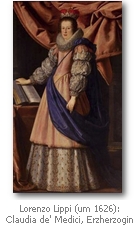
A Claudia de’ Medici should not lack for anything in Innsbruck, the capital of Tyrol. Court theater, horse ballet, boar hunts and lemons; Leopold even forbade public scourging for her sake. The Archduchess should not become upset; the precious baby she was carrying had to be protected at all cost. Unfortunately a girl, as would soon be revealed, but the rapidity with which Claudia became pregnant was cause for high hopes. Between 1627 and 1632 she bore five children, using the birthing chair she had brought with her from Florence: three princesses and – by God’s grace – two princes. The oldest daughter, her parents’ favorite, died at age two-and-a-half of dysentery; the youngest daughter was baptized after Leopold’s death. At 28 Claudia de’ Medici was widowed a second time. This time she had no need to fear the convent’s walls – quite the opposite; the death of her husband brought unexpected opportunity. Leopold had decreed in his will that in the case of his demise she should continue to rule Tyrol. Before her son came of age she enjoyed an independent reign of fourteen years.
The young sovereign plunged into her new task with enthusiasm. She did not have an easy time of it. The land was deeply in debt; she had to ask the emperor to admonish her ministers and councillors to follow her decrees. 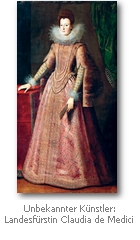 And then there was the Thirty Years’ War, which never seemed to end. Troops of France and of the Swedish king threatened the borders of Tyrol. Claudia de’ Medici therefore arranged for a reform of the Tyrolian militia, had fortifications built up and concluded an alliance with Spain and Emperor Ferdinand II. In this way she was able to preserve Tyrol from the worst harm. In internal affairs too she developed ambitious plans. She wanted Innsbruck to become a clean city, free from dung and muck, garbage, and prostitution. Adultery was harshly punished, and those accused of witchcraft were prosecuted without mercy, but according to existing law. She immediately dismissed and punished an official who had abused a ten-year-old girl. She alone had the power to grant pardons and made active use of it. She commanded that those who were condemned to death on the wheel or through burning or impalement had to be put to death first. Women who had killed their babies were given milder sen-tences than before. Under her rule Innsbruck’s streets were paved, and preventive measures were taken against fires and epidemics. She fostered trade, developed fisheries and planted mulberry bushes for silk production.
And then there was the Thirty Years’ War, which never seemed to end. Troops of France and of the Swedish king threatened the borders of Tyrol. Claudia de’ Medici therefore arranged for a reform of the Tyrolian militia, had fortifications built up and concluded an alliance with Spain and Emperor Ferdinand II. In this way she was able to preserve Tyrol from the worst harm. In internal affairs too she developed ambitious plans. She wanted Innsbruck to become a clean city, free from dung and muck, garbage, and prostitution. Adultery was harshly punished, and those accused of witchcraft were prosecuted without mercy, but according to existing law. She immediately dismissed and punished an official who had abused a ten-year-old girl. She alone had the power to grant pardons and made active use of it. She commanded that those who were condemned to death on the wheel or through burning or impalement had to be put to death first. Women who had killed their babies were given milder sen-tences than before. Under her rule Innsbruck’s streets were paved, and preventive measures were taken against fires and epidemics. She fostered trade, developed fisheries and planted mulberry bushes for silk production.
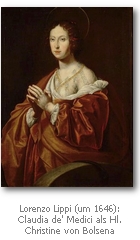
“God sees everything,” was her life’s motto. Protestants and Jews were tolerated only to a limited degree. Whoever failed to go to confession she expelled from the country. She commissioned numerous sacred works of art, among them a portrait of the martyr Christina of Bolsena: the ruler herself as a saint, with exposed shoulder and half-revealed breast, perhaps in imitation of Lucas Cranach’s Maria lactans (Nursing Mother of God), for which the pious Archduchess had donated an altar.
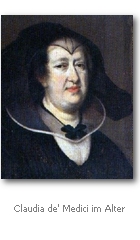
Claudia de’ Medici is the Tyrolian Landesfürstin (female ruler) most often captured in portraiture: in widow’s weeds, with writing quill, folio volume, lap dog or archduke’s hat. In her later pictures she appears spent, tired and bloated. The strenuous years of her reign seem to have marked her. Or perhaps it was the time afterwards, when she had to turn over the business of ruling to her son and was compelled to be idle. She lived two more years, during which Alsace, for which she had fought tirelessly, passed to France. Immediately after the end of the Thirty Years’ War she died from the effects of her edema.
trans. Joey Horsley
Author: Uta Ruscher
Literature & Sources
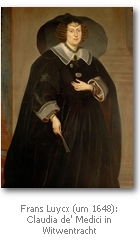
QUOTATION:
„Claudia’s memory remains a blessed one to all Tyroleans.”
Carl Zoller
LITERATURE:
Grottanelli, Lorenzo. 1896. Claudia de’ Medici e i suoi tempi. Firenze. Ufficio della Rassegna Nazionale
Weiss, Sabine. 2004. Claudia de’ Medici. Eine italienische Prinzessin als Landesfürstin von Tirol (1604 – 1648). Innsbruck – Wien. Tyrolia
For additional information please consult the German version.
If you hold the rights to one or more of the images on this page and object to its/their appearance here, please contact Fembio.




